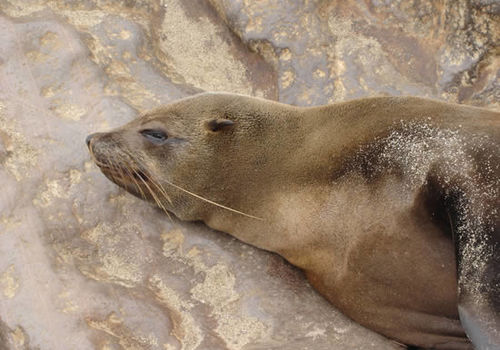
Cape fur seals
Arctocephalus pusillus pusillusCape fur seals
Introduction: The Cape fur seal (Arctocephalus pusillus pusillus) is a marine mammal and can only be found on the coast line of southern Africa. They are in abundance on the Cape Seal Cross Seal Reserve in Namibia, some 120km north of the seaside resort of Swakopmund. They were first sighted off the coast of southern Africa in 1884 and in 1922 the South West Africa government introduced legislation to control the utilisation of seals, a contributory factor in their survival and increased population.
Cape fur seals do not migrate but travel long distances along the southern African coast and have been found 200km away from shore. The unpleasant odour at Cape Cross is a combination of dead seals, excrement and strong wind that entwine the smell of the sea with the aromas of over 210,000 (breeding) seals. Nose plugs are optional!
They are warm-bloodied mammals that can regulate their body temperatures in the cold Benguela current which runs along the Skeleton Coast. Blubber and two layers of coarse hair help them to keep warm in the water and it is widely believed that they spend at least 30% of each month in the sea.
The Cape fur seal is built for the sea and is a fast and effective swimmer, as their limb bones are almost withdrawn into their bodies with only the flipper protruding. They can dive to over 400m and bulls can stay under water for over 10 min and females 7 min. Unlike other marine mammals the seal's nostrils are closed and their large eyes can see both forward and to the sides. This is a distinct advantage when it come to hunting and being hunted. Cape seals have external ears, a feature that sets them apart from true seals.
On the mainland they are at risk from black-backed jackals and brown hyenas. At sea, sharks and killer whales prey on the Cape fur seal. Apart from its exceptional swimming and hunting abilities, they have ridges on their soles of their flippers. This helps them climb wet, slippery surfaces such as rocks. They have sharp and pointed teeth which grips slimy seafood, but small fish are swallowed whole, head first so that fish scales do not scratch their mouths.
Larger fish present no problem to the Cape fur seal who shake their heads from side to side, tearing their prey first before eating them. This attracts gulls and other scavengers hoping to catch a piece of flying meat.
The social system of the Cape fur seal revolves around territorial bulls establishing territories at the beginning of the mating season. They are defended against rival bulls but cows are not confined to one territory.
Distribution: The coastline of southern Africa and the complete coastal area of Namibia from the Orange River in the south to Kunene River in the north.
Diet: Fish comprise of 90% of their diet, mainly sardine, anchovy, hake, gobies and horse mackerel. An adult Cape fur seal eats roughly 270kg of food a year. Small pups over 6 months old may eat small lobsters.
Colouring: Predominately grey-brown in colour, varying from light grey to almost black.
Breeding: The drama begins sometime in mid-October when rampant bulls come ashore to establish breeding territories. After displays of chest-to-chest combat, combined with performance of pushing and biting, the defence of their territories begins. Adult, pregnant cows begin to arrive offshore in early November and it is now the females turn to fight for a place within a territory. They give birth to a single pup within 1 or 2 days and cows mate 6 days after giving birth, which goes some way to explaining what all the fighting was about in the first place. Pups are weaned at 9 months and females maintain a 'shuttle feeding service' by feeding at sea for a few days before returning to shore to suckle their young. This is a perilous time for the pups and there is a 30% infant mortality rate, mainly due to the principal predatory actions of jackal and brown hyena.
Size: Adult males are larger than adult females. Males are 1.9m - 2.3m long and weigh between 200-350kg. Females are between 1.3m long and weigh between 40 – 80kg.
Klein Windhoek

